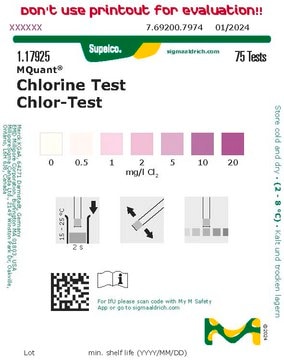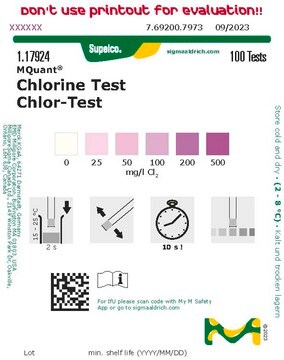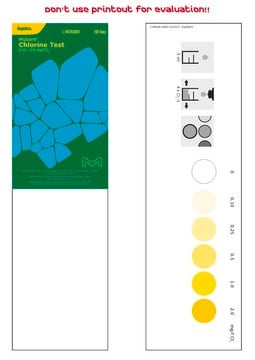1.14434
Chlorine Test Kit, colorimetric
0.010-0.30 mg/L (Cl₂), MQuant®
Sinónimos:
Chlorine Visual Test Kit
About This Item
Productos recomendados
product name
Chlorine Test, colorimetric, 0.010-0.30 mg/L (Cl2), for use with MQUANT®
product line
MQuant®
Quality Level
specific analyte(s)
chlorine
measuring range
0.010-0.30 mg/L (Cl2)
compatibility
for use with MQUANT®
detection method
colorimetric
storage temp.
15-25°C
General description
The test can be used in
- Drinking water and mineral water
- Waters from aquaculture
- Wastewater
- Electroplating wastewater
- Disinfectant solutions
This test is not suited for seawater.
Method
In weakly acidic solution free chlorine reacts with diethyl-p-phenylenediamine (DPD) to form a red-violet dye. The chlorine concentration is measured semiquantitatively by visual comparison of the color of the measurement solution with the color fields of a color card.
The unique brilliance of the print and their fine color graduation allow precise analyses, even at the lower end of the concentration range. Due to the long test tubes a sensitive measurement range can be covered. Using the refill pack 1.14977 containing all the reagents, the original test kit can be used for a very long time, making it a particularly economical and ecological system.
Application
- 3,3′,5,5′-tetramethylbenzidine as multi-colorimetric indicator of chlorine in water in line with health guideline values.: This study demonstrates the use of 3,3′,5,5′-tetramethylbenzidine as a colorimetric indicator for detecting chlorine levels in water, providing a cost-effective and simple method for ensuring water safety in compliance with health guidelines (Palladino et al., 2020).
- Analysis of free chlorine in aqueous solution at very low concentration with lateral flow tests.: Investigates the effectiveness of lateral flow assays for the quantification of free chlorine in water, highlighting their potential for quick and accurate chlorine testing in field settings (Schwenke et al., 2019).
- Improved residual chlorine test; the ortho-toluidine: arsenite method for testing water for true, false and chloramine residuals.: Describes a methodological advancement in measuring different forms of chlorine residuals in water, enhancing the accuracy of water quality assessments (GILCREAS FW, 1948).
Legal Information
signalword
Danger
hcodes
Hazard Classifications
Eye Irrit. 2 - Repr. 1B
Storage Class
6.1D - Non-combustible, acute toxic Cat.3 / toxic hazardous materials or hazardous materials causing chronic effects
wgk_germany
WGK 2
flash_point_f
Not applicable
flash_point_c
Not applicable
Certificados de análisis (COA)
Busque Certificados de análisis (COA) introduciendo el número de lote del producto. Los números de lote se encuentran en la etiqueta del producto después de las palabras «Lot» o «Batch»
¿Ya tiene este producto?
Encuentre la documentación para los productos que ha comprado recientemente en la Biblioteca de documentos.
Los clientes también vieron
Protocolos
AQA Standard for free chlorine - Preparation of a standard solution for free chlorine
Patrón de AQA para el cloro libre - Preparación de una disolución patrón para el cloro libre
Preparation of a standard solution for free Chlorine according to DIN EN ISO 7393
Preparación de una disolución patrón para cloro libre según la DIN EN ISO 7393
Nuestro equipo de científicos tiene experiencia en todas las áreas de investigación: Ciencias de la vida, Ciencia de los materiales, Síntesis química, Cromatografía, Analítica y muchas otras.
Póngase en contacto con el Servicio técnico












